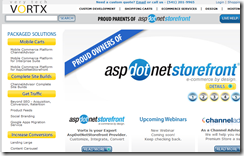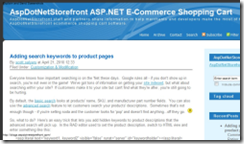When was the last time that you thought about, and I mean truly thought about, your checkout/shopping cart page on your eCommerce site? It is amazing how many people just accept the default rather than think about it from a conscious perspective.
Tag: aspdnsf
Access StoreId from Codebehind in AspDotNetStorefront
If you’ve ever worked in the codebehinds of the latest versions of AspDotNetStorefront, you’ve probably run into this problem before. Or perhaps you’re smarter than me and already knew this in which case, this isn’t for you. 😉
With the new Multi-Store feature in v9.x of AspDotNetStorefront, there are instances where you need to access the StoreId for one reason or another. The problem is, none of the available classes (this, order, page, etc) seemed to be exposing this value. You could look at this.SkinId but this is not an optimum solution since you can add multiple stores to the same Skin.
ASPDNSF v9.3 Released, What’s In It For You?
 Yes, you heard that right. The much talked about v9.3 of AspDotNetStorefront has been released today. However, is it right for you?
Yes, you heard that right. The much talked about v9.3 of AspDotNetStorefront has been released today. However, is it right for you?
In a word, Yes! This release incorporates not only a slew of code adjustments (aka bug fixes) that will benefit existing site owners but also two big new features as well as a slew of new mini-features/configuration options.
USPS Rate and Rate V2 APIs to Expire Soon
If you are running an ecommerce store that relies on real-time rate lookups from the U.S. Postal Service then hopefully you are already aware of this looming deadline (March 31, 2012) and have made arrangements to prevent this from crippling your business.
If you are running AspDotNetStorefront (our favorite ecommerce package) AND you rely on USPS as one of your Real Time Shipping lookups, you will need to know that you need to be running v8.0.1.4 or v9.1.1.0 of this fabulous package in order to be safe from this problem.
You’ll be able to confirm the version of your website by looking the left column of the admin control panel: Read more
Change Starting Order Number in ASPDNSF
From within your storefront’s “Run SQL” option under “Configuration” | “Advanced” (or from within SQL Mangler, I mean Manager, enter the following command:
dbcc checkident(OrderNumbers, reseed, XXXXXX)
Where XXXXXX is the new number you want to use as your seed.
This can come in very handy if you moving from one storefront to another to ensure a continuity of orders.
from: http://manual.aspdotnetstorefront.com/p-1335-changing-the-starting-order-number.aspx
Quickly Map Manufacturers to Store in ASPDNSF Multi-Store solution
 I’m sure you’ve been there before. You (or your customer) have gone in and added all your products and defined which products go with which stores but then decided after the fact that you want to have a manufacturer’s page (or menu) that shows all the manufacturers of products that exist in a give store on your Multi-Store solution.
I’m sure you’ve been there before. You (or your customer) have gone in and added all your products and defined which products go with which stores but then decided after the fact that you want to have a manufacturer’s page (or menu) that shows all the manufacturers of products that exist in a give store on your Multi-Store solution.
How To Extend ASPDNSF Product Name Field
On of the nice features of AspDotNetStorefront is that it supports multiple languages right out of the box. It does this by storing the multiple locale phrases as XML fragments inside the particular field. So, in the case of a product name, this means stuffing each of the multi-lingual product names into the Name field in the Product table. It also needs to be properly defined in this field with the XML code so a sample, multiple language name field could contain something similar to the following:
<ml>
<locale name=”de-DE”>CMS-6R4</locale>
<locale name=”en-US”>CMS-6R4</locale>
<locale name=”fr-FR”>CMS-6R4</locale>
<locale name=”ja-JP”>CMS-6R4</locale>
</ml>
AspDotNetStorefront Acquired by Vortx
 Wow, just when you think certainly areas of your life are pretty stable… Vortx, a leading integrator of AspDotNetStorefront software in Ashland, OR, announced yesterday that they had acquired the Ohio-based ecommerce company.
Wow, just when you think certainly areas of your life are pretty stable… Vortx, a leading integrator of AspDotNetStorefront software in Ashland, OR, announced yesterday that they had acquired the Ohio-based ecommerce company.
One interesting tidbit that can be found on the press release is that they are planning a marketplace of plug-ins. Hopefully this will be more along the lines of the Android app and Google Apps marketplaces than the iPhone app marketplace, if you get my drift.
Not surprisingly, AspDotnetStorefront website has no press release up about this acquisition.
More details to follow as it is released.
Deciding Which AspDotNetStorefront Is Right For You
A while ago, I wrote about how to decide which of the various versions of AspDotNetStorefront were right for your application. I think the guidelines in that article still hold true but now that there are more versions of the software available, it should be updated. Thankfully, the fine folks at AspDotNetStorefront have already done so in their blog. Here are some of the updated deciders (my comments on each of their points are added in blue italics):
AspDotNetStorefront Tip to Expose Keywords to Internal Search Engine
 The newly launched AspDotNetStorefront blog launched with a bang recently. In addition to taking advantage of the opportunity to introduce the world to some of their unsung heroes in the Sales and Support department, their first programming tip is something that proved to be quite timely to one of our clients who was experiencing a particular problem with the internal full-text search.
The newly launched AspDotNetStorefront blog launched with a bang recently. In addition to taking advantage of the opportunity to introduce the world to some of their unsung heroes in the Sales and Support department, their first programming tip is something that proved to be quite timely to one of our clients who was experiencing a particular problem with the internal full-text search.